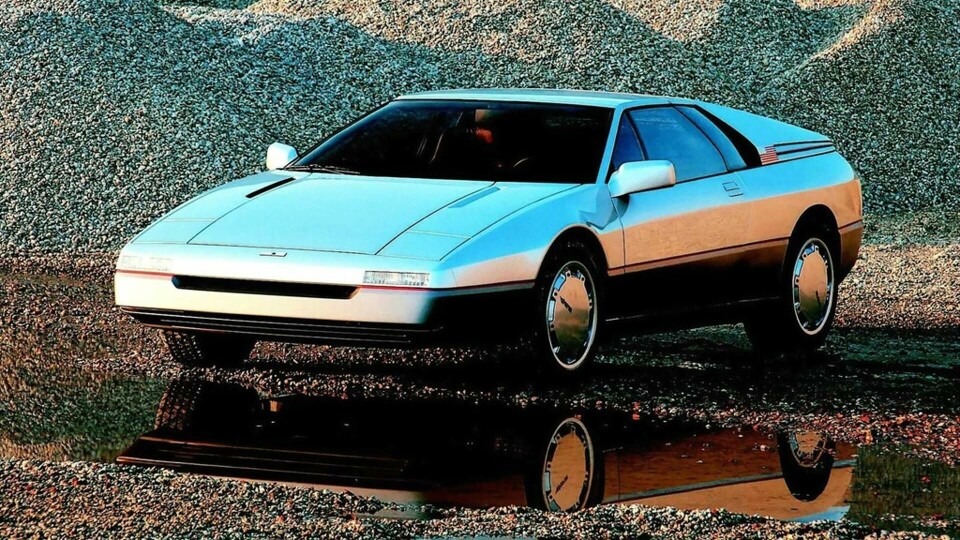
CCotW: Ford Maya (1984-5)
An everyman’s supercar designed by Giugiaro for the Blue Oval
Despite all its troubles, the personal and institutional drama, and the myriad of technical issues, John Z. DeLorean and his DMC12 sports car did make the mainstream automobile industry sit up and pay attention.

John DeLorean and his sports car. Would it be a game changer? The odds were long from the start
Few thought he had even slightest chance of succeeding, but some wondered: what if, against all odds, he did? What might be the impact on the industry of an independent player with a sexy, gullwinged sports car? It would be niche player for sure, but a highly influential one.

In 1984 the Mustang turned twenty. Would it soon have a sibling?
While so much attention had been focused on DeLorean, Ford had quietly been looking into a sports car project for some time. The Mustang, the Blue Oval’s pony car, was a perennial strong seller. But could there be room for higher-end sports car at Ford?
By 1984, the DeLorean threat had passed, but interest in an everyman’s supercar remained. Ford and ItalDesign teamed up to explore the possibilities of a sports car of superior packaging and performance that could be produced at a volume of 50 cars per day (about 12,000 a year) – either in Italy or America.

Italdesign sketch for the Ford Maya sports coupé
Ford was not only tapping into Giugiaro’s masterful design talents, but his encyclopaedic knowledge of manufacturing techniques. After, all it’s one thing to make, say, a tie rod assembly, but it’s another thing to make it so it can be manufactured and easily installed fifty times a day.

Maya – a classic Giugiaro wedge
The resultant design from ItalDesign was a wedge-shaped, two-seat coupé with a mid-engine layout. It was similar to other Giugiaro wedges of the time – the Mangusta, the Boomerang and the Tapiro, to name a few – but again, it was not just the design that was important; it was the ease of manufacture that would make the car a viable prospect.

Cross-section of the Maya – mid-engine, actual luggage space and roomy cockpit
Within the wedge-shaped profile was a 140bhp, three-litre V6 engine mounted amidships. This apparently was just a placeholder, as a more powerful 250bhp V6 was in development. The front trunk was surprisingly roomy and could hold actual luggage.

The Maya interior – spacious cockpit for two and luggage
The interior was spacious for a sports coupé, with leather bucket seats and a sculptural instrument panel with recessed instrumentation. The steering wheel held almost all controls at the hub similar to the earlier Lancia Medusa concept.
Behind the seats was space for more luggage instead of a useless back seat. At the roof was a ‘targa top’ to open the car up to the sky.

At the hub of the steering wheel, plenty of controls
The Maya was introduced at the 1984 Turin Motor Show. It was a well received, but Ford wasn’t finished with the experiment. They returned to ItalDesign and, in 1985, had two other prototypes created. The first, called the Maya II ES, was a sports coupé with smoother lines and central hood vent louvers similar to a Ferrari.
Ford painted it a brilliant red for the show circuit, but when it returned to Italy, Giugiaro’s team quickly returned it to a sensible silver colourway, much like the first Maya.
The second version of that year was a notchback coupé with a more powerful 300bhp V6 engine.

The Maya II ES; a more Ferrari-like version of the Maya, complete with red paint
In the end, Ford would pass on the project. The Maya did look like the ItalDesign concept Etna for Lotus, again in 1984. The Etna seemed destined for production, and Ford didn’t want its ‘halo car’ to be seen as a copycat.
Also, the cost of each car may not have pencilled out. Ford needed a certain volume and price point for the American market, and, in the end, it may not have been possible – or Ford may have decided that the Maya would have cannibalized Mustang sales.

A notchback version of the Maya sported a more powerful engine
The Maya was not the absolute best design of Giugiaro’s wedges (everyone has their favourite), and it was certainly not the most technologically advanced. But the Maya was not a just a concept car, it was a fully running prototype. Everything worked and it was prepared to be a testing mule. There was a practicality and a finished quality about it that eludes most concept cars.
Was the Maya a lost opportunity? Opinions differ. If the car wasn’t practical as a Ford, perhaps it might have been a Lincoln coupé, changing that brand’s stodgy image. We will never know. The Maya has long since joined the ranks of those concepts we sigh wistfully and classify as “what might have been.”




